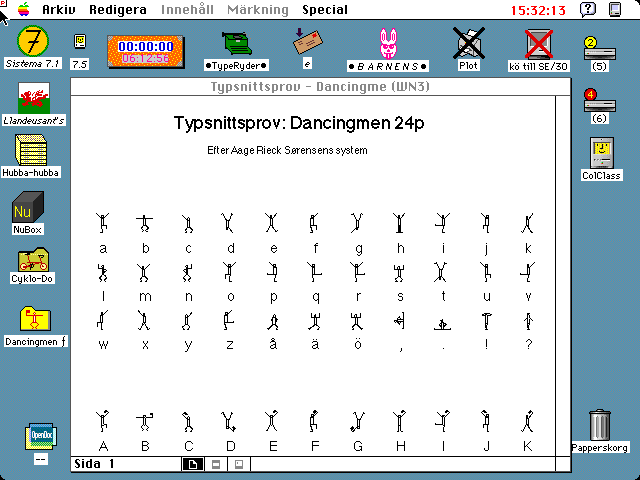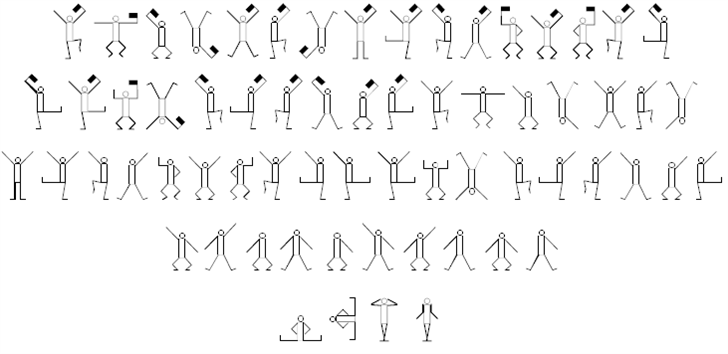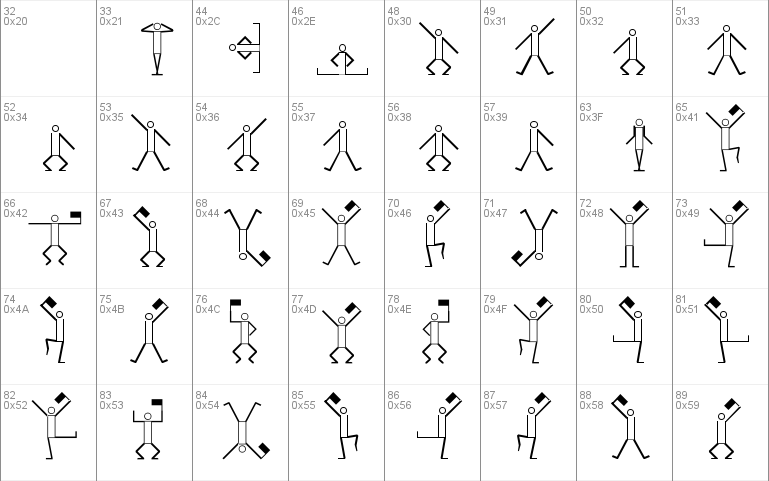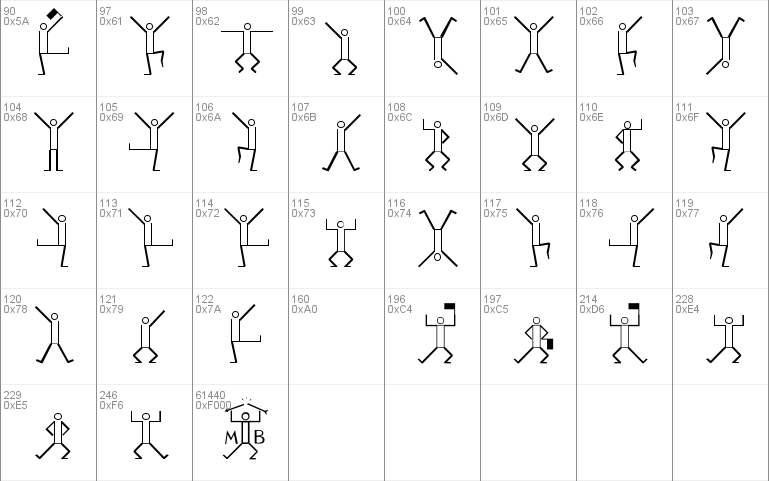



- Styles (1)
- Character Maps
- License


- Free for Personal Use
- Free for Commercial Use
- Modification Allowed
- Redistribution Allowed
Extended information
Based on the code featured in the Sherlock Holmes adventure "The Dancing Men" that baffled Mr. Hilton Cubitt of Ridling Thorp Manor, with characters added to complete the alphabet. Send secret messages to your friends warning them of danger!
Read more
The Dancingmen font - (http://goto.glocalnet.net/tedbe/sh/files/dancingmen.html)
2010/02/21 23:17:16
----------------------------------
Home > Sherlockiana > Articles, etc > "This item"
Strange Little Dancing Men
Explained at Last
A cipher font, contributed by Martin Bergman circa 1998
Origins
The distinctly "anthropomorphic" characters that constitute these TrueType" and bitmap font files are based on the secret alphabet used by a gang of American criminals in the Sherlock Holmes adventure "The Dancing Men", first published in 1903.
As Mr. Holmes soon deduced, their puzzle was actually a rather unsophisticated substitution cipher, i.e. the cryptographic method in which each character of the normal alphabet is globally substituted by another discrete (and seemingly nonsensical) sign or image. To use a modern metaphor: "As if the keyboard had been totally remapped".
From the rather limited information offered by the narrator Dr. Watson it is difficult even for the most reflective reader to conclude whether the actual character images were choosen totally at random, or if there is a logical system behind the bizarre postures of all those little "dancing men". Indeed, judging by the contemporary original illustrations, a few characters are not even consistent from one message to another!
The fact that in this short story only 17 out of the 26 basic letters of the English alphabet are documented, has naturally led to deep thought and speculation by Sherlockian scholars everywhere. Over the years a number of essays and articles on the subject has appeared in the specialist journals. About 25 years ago a leading Danish Sherlockian, Aage Rieck S�rensen, privately published what appears to be the definite analysis of this obscure alphabet. In his paper Mr. Rieck S�rensen partly derives, partly devises a coherent icono-semantic system that not only "fill in the white spots" (i.e. the missing letters) but establishes a pleasingly symmetric hidden pattern. It is true that the accepted postures for some of the characters had to be revised to fit the logic of this neat schema, but all-in-all his solution was satisfying.
This is the font layout, then, on which my typeface Dancingmen is based. Alterations to the basic character set include the addition of numerals, the full stop (U.S. = period) <.>, exclamation and question marks. Also the three letters that are unique to the alphabets of the Swedish, Norwegian, and (to some extent) Danish, Finnish, German, Hungarian and Turkish languages, namely the characters A and O superscribed by "dots and rings": �/�, �/� and �/� (i.e. Mac ASCII numbers 129/140, 128/138, 133/154 and ISO Latin-1/HTML 7-bit ASCII 197/229 [Aring/aring], 196/228 [Auml/auml], 214/246 [Ouml/ouml]) generally corresponding to the diphtongated vowels spelled AU, AE and OE respectively in Latin and related languages.
How to use this font
As the Master Sleuth was able to show almost a century ago, one of the basic features of the original "Dancing Men" cipher was the curious ortographic rule that all conventional spacing between words should be omitted (as should capitalisation of initial letters). Instead, the text-string of each word is terminated by the insertion of a little flag in the hand of the last "man" of the string - thereby in effect flagging the hidden interverbal spaces.
Accordingly, there are no actual "upper" or "lower" case letters in the Dancingmen font. In contrast to normal writing rules, all text should be written with lower case letters (i.e. without using the shift key), except for the last letter of each word! When the shift key is pressed that ultimate letter gets the required little flag.
The quickest way to write a message, headline etc with this font is to first type the text down completely in a common "readable" font like Geneva (carefully adhering to the writing rules above, of course), and then finally changing the font to Dancingmen. Now you have a secret text, guaranteed to puzzle all but the most brilliant detectives!
At smaller text sizes, the single size bitmap font used for the monitor rendering makes the Dancingmen characters rather difficult to see. 24 points is minimum for decent screen readability.
Martin Bergman


Comments